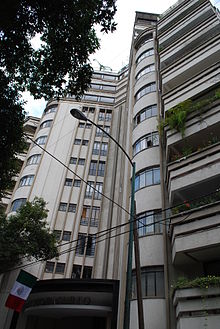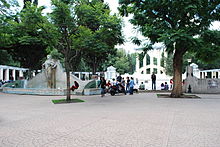- Colonia Hipódromo
-
Colonia Hipódromo is a colonia (neighborhood) west of the historic center of Mexico City in the Cuauhtémoc borough. It is one of three colonias that are jointly known as “La Condesa.” The colonia and the La Condesa area is centered on Parque México, a large park built on a former private racetrack belonging to the Countess (Condesa) of Miravalle. This park has been recognized for its historic value by the Instituto Nacional de Antropología e Historia. The area is also known for its architecture, especially in Art Deco, which was popular when much of the colonia was built in the early 20th century.
Contents
Description
The colonia is located west of the city center in an area known as “La Condesa.” This has caused it to be mistakenly referred to as part of Colonia Condesa, as it shares much of the areas distinct architecture and Bohemian atmosphere.[1][2] The colonia is centered on Parque México, with most of its streets either curving to parallel the layout of the park or leading to it.[3] There are traffic circles (roundabout) decorated with Art Deco fountains, such as those at Plaza Iztaccihuatl and the Popocateptl circle.[4]It is bordered by the following streets: Avenida Yucatán and Avenida Alvaro Obregón in the north, Eje 4 Sur Benjamín Franklin and Nuevo León in the south, Avenida Insurgentes in the east and Avenida Tamaulipas in the west.[5]
A distinctive feature of this colonia is its large proportion of green areas in relation to paved areas. These green areas include the Parque México, Parque España, the centers of the traffic circles of Popocatépetl, Iztaccíhuatl and Citlaltépetl—and the center dividers on Avenida Amsterdam, Calle Sonora, Calle Nuevo León, and Calle Tamaulipas. Combined, these make up about 40% of the colonia’s surface area.[5]
Colonia Hipódromo, like the rest of the Condesa area, has a number of notable architectural examples, especially in Art Deco and more modern styles. Parque México, Plaza Iztaccíhuatl and Popocatépetla have Art Deco fountains and other features.[4] Its avenues are wide and lined with trees. It is mostly residential but also filled with restaurants, cafés, boutiques and art galleries. Many of the houses in the area, along with the Edificio San Martín, are in Art Deco as well.[3] Like other parts of the Condesa area, Hipódromo has a number of international restaurants, bars and nightclubs. One of these restaurants is called Escarapela, located near Parque España, which serves a mix of Italian and Argentinean food.[2]
In Colonia Hipódromo not everything is food, parks and art Decó. It also has a number of magnificent stores, such as an American Apparel, many vintage stores, etc. It also has bookstores, such as the Fondo de Cultura Económica, Librería Rosario Castellanos. which is one of the biggest bookstores in Latin America. and a Péndulo, which is a great bookstore where you can also have a coffee or a meal while reading.
Landmarks
Edificio Basurto
The Edificio Basurto is an Art Deco building which is noted for its used of curved and straight lines in its form. It was built on irregularly shaped land which used to be the garden of a man named Basurto. Others built the structure but he authorized the use of his name. The structure was designed by architect Francisco J. Serrano on Avenida Mexico with a view of Parque México and the Popocatepel Plaza.[6]
Parque Mexico and Parque España
The center of Colonia Hipódromo and the La Condesa area is Parque México.[1] The park not only serves as the center of Colonia Hipodromo, it is also the defining element of “La Condesa”[4] It is also considered to be the “lungs” of this portion of the city.[7] The park has been recognized by the Instituto Nacional de Antropología e Historia (INAH), as part of the heritage of the entire city.[3]
It is located on the former race track of the Countess of Miravalle’s hacienda, as due to environment laws in the 1920s, housing could not be developed on this land. Instead, it was decided to make the area into a park as the focus of the neighborhood. Today, the park still serves as an attraction to those who settled in the La Condesa area.[8]Around the park are a number of important architectural examples from the 1920s such as the Edificio San Martín, also called the Edificio México.[4]
Smaller, but located very near to Parque México is Parque España, located among Nuevo León, Sonora and Parque España streets. It was established in 1921 to commemorate the 100th anniversary of the end of the Mexican War of Independence. It contains statues such as the monument to Lázaro Cárdenas.[2] In 2008, the park was renovated and remodeled at a cost of over 12 million pesos. One of new additions was playground areas.[9] In 2009, it was declared as the “Territory of Music and Poetry” (Territorio de Música y Poesía).[2]
Edificio San Martín
The Edificio San Martín (San Martín Building), also known as Edificio México, is an representative example of Art Deco architecture in Mexico, which was popular in the 1930s. By the late 1990s, the building was nearly in ruins, but it was restored between 1998 and 2001 by architect Carlos Duclaud. While Duclaud did made some changed to the interior, most of the original plan of the building remains intact. One major change was made. In the 1930s, apartment building windows with the best views were in the bedrooms, rather than in the living room and dining room. This was switch to the more modern arrangement, by rearranging interior walls. However, the facades, and most of the public areas such as stairwells were kept true to the original, with the aim of keeping the buildings original “identity.”[10]
Fideicomiso Archivos Plutarco Elías Calles y Fernando Torreblanca
Overlooking this Parque España is a mansion that belonged to Fernando Torreblanca, personal secretary to Álvaro Obregón and Hortensia Elias Calles. It was designed by engineer Manuel Luis Stampa. The mansión is now the el Fideicomiso Archivos Plutarco Elías Calles y Fernando Torreblanca (FAPECyFT), which houses many documents related to the country’s history after the Mexican Revolution .[2]
History
The first owner of the lands here was Maria de la Campa y Coss, Countess de Santiago de Valparaíso. She married Miguel Berrio y Zaldívar, the Marquis of Jaral de Berrio. The union produced a daughter, Ana María de Berrio y Campa, who married Pedro de Moncado y Branciforte. This produced the Marquesa of San Roman. This family owned these rather large expanses of land in what is now western Mexico City until the second half of the 19th century. A horse from this estate served as a model for the one in the statue of Carlos V by Manuel Tolsá[6][11]
When the last of the direct descendants of the couple died, the land was divided and some of it was acquired by a new owner, María Magdalena Dávalos de Bracamontes y Orozco, the Countess of Miravalle. She converted her property into a hacienda with a manor house, which still exists. The neighborhood is named after this countess. The lands of this hacienda extended over what is now Colonia Roma, Colonia Condesa, Colonia Hipódromo and part of Tacubaya.[6][11]
In the early 20th century, the Condesa’s private race track was initially operated by the Sociedad del Jockey Club Mexicano, which used it automobile racing as well as horse racing. However, eventually all of the former hacienda were developed into residential areas by the 1920s.[5] This development divided the former hacienda into Colonia Hipódromo , Colonia Condesa, Colonia Hipódromo Condesa and Colonia Roma. However, the first three colonias are better known together as “La Condesa.”[11]
Along with these other colonias, Hipódromo was popular with the middle and upper classes, as well as a number of foreigners, such as the Spanish refugees from the Spanish Civil War and Jewish immigrants.[4][12][5]<[13] All this gives the area an urbane and cosmopolitan reputation.[4][2]Development in the first half of the 20th century brought in Art Deco, blending sharp angles, straight lines and curves. Two local traditions that were developed were “neo-colonial” and “California colonial” based on Spanish constructions in that state. There are also some buildings with a decidedly functional look.[12]
The La Condesa area was somewhat abandoned after the 1985 earthquake. Since that time, however, it has experienced a comeback, initially attracting artists and students with low rents, and later intellectuals and young businesspeople. The area has been compared to SoHo in New York and the Latin Quarter in Paris.[4] This redevelopment has brought in new construction, restaurants, bars and nightclubs. These have added to the colonia’s urbane and Bohemian reputation but has also brought in problems such as parking and inadequate infrastructure.[2]
References
- ^ a b "Urbanismo: Parque México: Pulmón de la colonia Condesa." (in Spanish). Arquitectura Mexicana. Mexico. http://noticias.arq.com.mx/Detalles/9255.html. Retrieved September 8, 2010.
- ^ a b c d e f g Lina (January 13, 2010). "De paseo por el Parque España… Su historia y el lugar…" (in Spanish). MX-DF.net. Mexico. http://www.mx-df.net/2010/01/de-paseo-por-el-parque-espana-su-historia-y-el-lugar/. Retrieved September 8, 2010.
- ^ a b c "Analizan el Parque México" (in Spanish). Mexico: INAH. January 27, 2008. http://dti.inah.gob.mx/index.php?option=com_content&task=view&id=492&Itemid=67. Retrieved September 8, 2010.
- ^ a b c d e f g "Colonia Condesa" (in Spanish). http://ciudadmexico.com.mx/zonas/condesa.htm. Retrieved August 31, 2010.
- ^ a b c d "Colonia Hipódromo" (in Spanish). Mexico City: Borough of Cuauhtémoc. http://www.cuauhtemoc.df.gob.mx/delegacion/mapa/colonias.html. Retrieved September 8, 2010.
- ^ a b c "Colonia Condesa" (in Spanish). Mexico: Instituto Mexicano de la Radio. December 11, 2007. http://www.imer.gob.mx/index.php?option=com_content&task=view&id=216. Retrieved August 31, 2010.
- ^ Rocío González Alvarado (March 27 2008). "El parque México, otro punto de conflicto entre los residentes de la colonia Condesa" (in Spanish). La Jornada (Mexico City). http://www.jornada.unam.mx/2008/03/27/index.php?section=capital&article=040n1cap. Retrieved September 8, 2010.
- ^ "Parque México" (in Spanish). http://ciudadmexico.com.mx/atractivos/parque_mexico.htm. Retrieved August 31, 2010.
- ^ "Inaugura Ebrard remodelación en Parque España" (in Spanish). El Universal. Notimex (Mexico City). January 6, 2008. http://www.eluniversal.com.mx/notas/472288.html. Retrieved September 8, 2010.
- ^ "Edificio San Martín" (in Spanish). Mexico: Obras Web. http://www.obrasweb.com/art_view.asp?seccion=Portada&cont_id=3312. Retrieved September 7, 2010.
- ^ a b c "Colonia Condesa" (in Spanish). Mexico City: Borough of Cuauhtémoc. http://www.cuauhtemoc.df.gob.mx/delegacion/mapa/colonias.html. Retrieved August 31, 2010.
- ^ a b David Lida (February 2002). "Mexico City’s Colonia Condesa, The War Between the Trendy and The Traditional". Mexico Files Newsletter. http://www.mexicofile.com/mexicocityscoloniacondesa.htm. Retrieved August 31, 2010.
- ^ Yetlaneci Alcaraz (April 9, 2009). "Colonia Condesa: ayer y hoy… [Colonia Condesa: Yesterday and today…]" (in Spanish). Ciudadanos en Red Boletín Semanal (Mexico City). http://www.metropoli.org.mx/node/16575. Retrieved August 31, 2010.
Colonias and Neighborhoods of Cuauhtémoc, D.F. Colonias Colonia Centro • Colonia Doctores • Colonia Obrera • Colonia Roma • Tepito • Colonia Algarín • Colonia Ampliación Asturias • Colonia Asturias • Colonia Atlampa • Colonia Buenavista • Colonia Buenos Aires • Centro Urbano Benito Juárez • Colonia Condesa • Colonia Cuauhtémoc • Colonia Esperanza • Colonia Exhipódromo de Peralvillo • Colonia Felipe Pescador • Colonia Guerrero • Colonia Hipódromo • Colonia Hipódromo Condesa • Colonia Juárez • Colonia Maza • Colonia Morelos • Colonia Paulino Navarro • Colonia Peralvillo • Colonia San Rafael • Colonia San Simón Tolnahuac • Colonia Santa María Insurgentes • Colonia Santa María la Ribera • Unidad Habitacional Nonoalco-Tlatelolco • Colonia Tabacalera • Colonia Tránsito • Colonia Valle Gómez • Colonia Vista Alegra • Zona Rosa
19°24′39.26″N 99°10′8.53″W / 19.4109056°N 99.1690361°WCoordinates: 19°24′39.26″N 99°10′8.53″W / 19.4109056°N 99.1690361°W
Categories:- Neighborhoods in Mexico City
- Art Deco
Wikimedia Foundation. 2010.



